| |
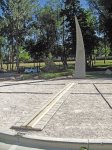 |
Colorado Springs |
Colorado |
USA |
Obelisk or Vertical Gnomon |
Dial 696 |
| A point-in-space or nodus dial with a 65 foot diameter dial face with seasonal markers extending nearly 150 foot wide due to uneven terrain. Time and date are indicated by the shadow of the tip of the 15 foot high curved gnomon. The dial is made of concrete, steel angle, cast iron and Breeze Stone, a compacted crushed stone. Roman hour numerals are cast iron, cast by students at The Colorado Springs School. The dial was designed and built by students, alumni and faculty of the school over a five year period. Provision is made for 60 stone date markers, set to indicate dates of significance to the school calendar. |
| |
| |
 |
South Burlington |
Vermont |
USA |
Sun Alignment |
Dial 695 |
| A calendrical dial sculpture of light beams projected onto the crushed stone surface of a 60 foot diameter meditative labyrinth. Two cylindrical focusing mirrors are located atop 10 foot poles and project short bars of sunlight that wander around the labyrinth but intersect on the equinoxes and winter solstice to form a cross at the center of the labyrinth at solar noon. |
| |
| |
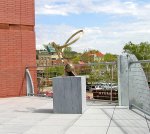 |
Burlington |
Vermont |
USA |
Reflective Equatorial |
Dial 694 |
| A 40 inch tall, helical, lens focusing projection equatorial dial of bronze and glass. A sliding time scale adjusts for longitude, DST and EOT. Cylindrical focusing mirrors project a sharply focused band of light on the inside of the helical time scale. This is a Precision Sundials Renaissance sundial. |
| |
| |
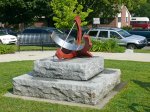 |
Burlington |
Vermont |
USA |
Equatorial Dial |
Dial 693 |
| An approximately 30-inch diameter equatorial dial of painted steel with a sandblasted stainless steel dial plate. Dial face has two hour circles showing EST and EDST with Arabic numerals. Longitude correction is not included and there is no EOT information provided. |
| |
| |
 |
Burlington |
Vermont |
USA |
Analemmatic Dial |
Dial 692 |
| This Circles of Peace dial is a combination calendrical and analemmatic design consisting of fourteen 5 to 10 foot high granite stones in a 43 foot diameter circle oriented to align with sunset on the solstices, equinoxes and cross-quarter days. An inner sixteen foot major diameter analemmatic dial includes 12 hour marker stones and a central stone that also shows the directions of sunset on the corresponding major dates. The calendar stone calculations and survey placement was done by NASS member Bill Gottesman. |
| |
| |
 |
Boulder City |
Nevada |
USA |
Vertical Dial |
Dial 691 |
| A 2x3 foot vertical stained glass dial declining 44.3° west of south permanently located in the living room window of a private residence. Dial has a uniquely attached point-in-space nodus on a perpendicular gnomon secured with a magnet to an embedded steel disk in the glass dial face, preventing damage should the gnomon be struck. Dial face includes hour numerals, half-hour lines, solstice and equinox lines and a solar noon mark. Dial face consists of 210 pieces of glass, 40 feet of lead and zinc came and 20 engraved and hand painted pieces of glass. The frog-shaped perpendicular gnomon can be replaced with a ball-shaped gnomon. |
| |
| |
 |
Auburn |
Maine |
USA |
Obelisk or Vertical Gnomon |
Dial 690 |
| A Vertical Gnomon Dial painted on an asphalt parking lot using the tip of a vertical light pole as the gnomon. Dial face includes hour lines, solstice and equinox lines and a compass rose showing true north direction. Markings include an analemma on the noon line with monthly marks. The dial is used as a teaching tool with formal lessons for students. The dial was designed using calculations from Naval Observatory. |
| |
| |
 |
Burnaby |
British Columbia |
Canada |
Horizontal Dial |
Dial 689 |
| A simple horizontal dial with a pipe gnomon in a gravel bed, about 6 feet in diameter. Flush stone hour markers have raised Roman numerals. Unfortunately, several of the hour markers are incorrectly positioned, and moss and weeds partially obscure much of the dial face. Because of the presence of trees all around it, the dial only receives the sun in the middle of the day, and hardly at all in the winter half of the year. A plaque nearby explains that dial was installed to celebrate the opening of Burnaby Lake Park in 1977. |
| |
| |
 |
Wendell |
Massachusetts |
USA |
Vertical Dial |
Dial 688 |
| A 15x5 foot hammer formed copper vertical dial declining 8? east of south with hour and half hour lines and Roman hour numerals. Gnomon is supported by dual braces. An EOT correction graph is provided and includes the inscription, "For every purpose there is a season" and acknowledgment to Friends of the Library and the Massachusetts Cultural Council. |
| |
| |
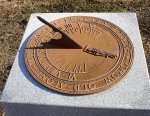 |
Vincennes |
Indiana |
USA |
Horizontal Dial |
Dial 687 |
| a 14 inch diameter cast metal horizontal dial with 15 minute hour lines and Roman hour numerals. Sunrise and sunset times at solstices marked by additional lines. Dial face includes grim reaper figure. Hour lines and gnomon may be designed for different latitude; this may be a commercial dial but it is clever and unrecognized if so. Dial sits on a square tapered marble pedestal with stepped square bases. |
| |
| |
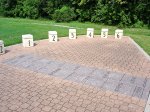 |
Houston |
Texas |
USA |
Analemmatic Dial |
Dial 686 |
| A large analemmatic dial of paving stones, square limestone hour posts with Arabic hour numerals and polished granite date line. Hour numerals show Standard Time. Dial has a concrete border around perimeter. |
| |
| |
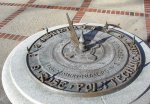 |
Terre Haute |
Indiana |
USA |
Horizontal Dial |
Dial 685 |
| A round bronze horizontal dial with 6 AM to 6 PM hour lines and half-hour lines and Arabic hour numerals. Eight perimeter points and the one central decorative point may represent alignments but no explanation is given. Dial sits on a carved stone column. Base marked 1920 1921 1922 1923. |
| |
| |
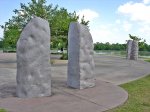 |
Houston |
Texas |
USA |
Sun Alignment |
Dial 684 |
| A large concrete, paving stone and standing stone calendrical dial with interior labyrinth. Outer ring shows NESW alignments. Four split standing stone portals are aligned for summer and winter solstice sunrise and sunset. An inner ring contains 13 trees representing the 13 cycles of the moon. |
| |
| |
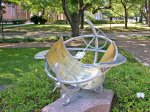 |
Houston |
Texas |
USA |
Cylindrical Dial |
Dial 683 |
| A 32 inch partial armillary of anodized aluminum and steel with wide equatorial and horizon rings and with equinoctial colure, Arctic and Antarctic circle rings. The gnomon includes an aperture to project a solar image on the wide equatorial ring, which includes EOT corrections, graphic for date determination and Zodiacal symbols. Reverse of gnomon aperture includes the university crest. Horizon ring graphic shows time of sunrise/sunset throughout the year. Dial is partially shaded by surrounding trees. Dial sits on an approximately 4 foot high polished granite pedestal |
| |
| |
 |
Sidney |
British Columbia |
Canada |
Armillary Sphere |
Dial 682 |
| A 20 inch diameter brass armillary sphere with equatorial, meridian and equinoctial colure rings. Gnomon has two nodus balls that may show solar position at solstices. Equatorial ring has 15-minute marks and Arabic hour numerals. The dial alignment needs adjustment for its current location. |
| |
| |
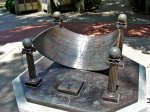 |
Columbus |
Ohio |
USA |
Cylindrical Dial |
Dial 681 |
| A cast bronze equatorial dial with inscribed analemma EOT figures on each hour line. Equatorial ring is a spherical segment. Arabic numerals mark Standard Time. Gnomon is missing. Dial sits atop a fluted Roman column on square base. |
| |
| |
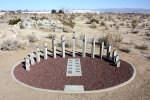 |
Ridgecrest |
California |
USA |
Analemmatic Dial |
Dial 679 |
| A 20x15 foot axis analemmatic dial built of cement hour posts, metal markers and tile and lava rock on the high desert floor outside the museum building. |
| |
| |
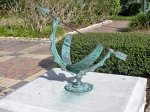 |
League City |
Texas |
USA |
Equatorial Dial |
Dial 678 |
| A small ornate bronze equatorial dial with Roman numeral hours marked on inside of equatorial ring and Zodiacal signs on back side and also on base of dial. Dial is places on a flagstone and cement pedestal. |
| |
| |
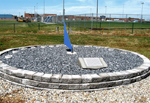 |
Fort Wayne |
Indiana |
USA |
Horizontal Dial |
Dial 677 |
| A 15 foot diameter stone and cement horizontal dial with a painted steel gnomon. 6 AM to 6 PM hour markers have Arabic numerals. Interior area of dial is filled with crushed rock. A plaque provides EOT and longitude corrections and instructions. This dial was an Eagle Scout project built for this elementary school for use in science lesson plans. Dial sits within a two-course stone perimeter pedestal. |
| |
| |
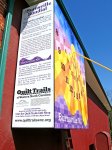 |
Burnsville |
North Carolina |
USA |
Vertical Dial |
Dial 676 |
| The Quilt Block Sundial, an 8x8 foot painted wood nearly-south facing vertical dial with a steel gnomon rod. Dial face consists of a bold quilt block pattern and includes Arabic hour numerals for local solar time, EST and EDT. Hour lines are corrected for longitude and EOT correction is provided by the profile of purple hills along the bottom of the dial. The star map at the top of the dial represents the starry sky at the first sunrise over the newly formed Yancy County on December 29, 1833. The dial declines 3deg west of south. A 3 foot thick steel frame locates dial away from wall to clear roof overhang. |
| |
| |
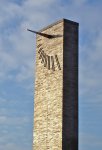 |
Columbus |
Indiana |
USA |
Vertical Dial |
Dial 675 |
| An approximately 10 x12 foot brick and stainless steel south-facing dial atop a 50 foot tower. This resembles an actual vertical dial but has a horizontal gnomon rather than a polar-pointing gnomon. The hour lines verify against ZW2000 software calculated angles for a due south dial but are non-functional with a horizontal gnomon. Dial face includes hour lines for 6 AM to 2 PM but no numerals. It's more sculpture than sundial. |
| |
| |
 |
Columbus |
Indiana |
USA |
Horizontal Dial |
Dial 674 |
| A 10 foot diameter horizontal dial of concrete, stainless steel and brick. The gnomon is a massive concrete structure and the Arabic hour markers are inset in the concrete dial face, which serves as a bench. |
| |
| |
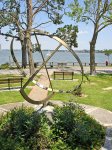 |
Clear Lake Shores |
Texas |
USA |
Armillary Sphere |
Dial 673 |
| An approximately four foot diameter ring equatorial dial of painted steel with Roman numeral hour marks and a long double-bar steel gnomon. Ring is sagging somewhat at base support, perhaps from being climbed upon. |
| |
| |
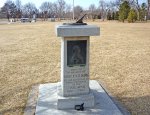 |
Denver |
Colorado |
USA |
Horizontal Dial |
Dial 672 |
| A cast bronze round horizontal dial with 4 AM to 7 PM hour lines and Roman numerals. The gnomon has an unusual curved root, making it appear to be misplaced to the south on the dial face when it appears to actually be correctly placed. Dial sits on a marble pedestal |
| |
| |
 |
Newport |
Rhode Island |
USA |
Vertical Dial |
Dial 671 |
| An 8x8 foot vertical dial of carved stone with hour lines and Arabic numerals and with Zodiacal symbols around dial perimeter. Dial declines to the west and has a bronze gnomon.
Access to view dial is available to all campus visitors. |
| |
| |
 |
Chattanooga |
Tennessee |
USA |
Obelisk or Vertical Gnomon |
Dial 670 |
| An 18 foot diameter horizontal dial of concrete and pebble with a cast bronze figure of a boy with outstretched arm, the 8 foot high finger tip of which serves as a point-in-space gnomon. The dial face includes hour marks and declination lines. An open book plaque on the bronze statue base gives instructions. |
| |
| |
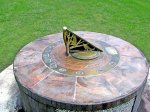 |
Albuquerque |
New Mexico |
USA |
Horizontal Dial |
Dial 669 |
| A 36 inch diameter brass and copper horizontal sundial with a gnomon depicting a bird standing and a bird in flight. The bird motif reminds of "The Bird of Time has but a little way to fly--and Lo! the bird is on the Wing" by Omar Khayyam.
The gnomon is buttressed for strength and includes a brass ball at the top as a safety feature in light of a nearby middle school. |
| |
| |
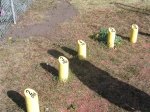 |
Calgary |
Alberta |
Canada |
Analemmatic Dial |
Dial 668 |
| An analemmatic dial with 14.8 foot major axis with hour posts and date line of concrete on a grassy playground. Date line includes footprints of cut aluminum. |
| |
| |
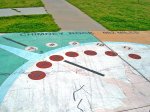 |
Omaha |
Nebraska |
USA |
Analemmatic Dial |
Dial 667 |
| A 20 foot square dial painted on concrete. Painted hour markers in two arcs for ST and DST include longitude correction. A nearby plaque provides instructions for use of dateline but has the hour marker arcs miss-labeled for ST and DST. |
| |
| |
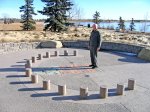 |
Calgary |
Alberta |
Canada |
Analemmatic Dial |
Dial 666 |
| An analemmatic dial with 14.8 foot major axis of concrete, pebble and rock with cast concrete hour markers. Hour lines are longitude corrected and mark DST. A Zodiac date line of colored concrete is inlaid on the dial face. Seasonal markers for sunrise and sunset are included. |
| |
| |
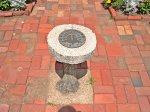 |
Omaha |
Nebraska |
USA |
Horizontal Dial |
Dial 665 |
| A bronze horizontal dial with 5 AM to 7 PM hour lines and Roman numerals. Placed on a cast concrete pedestal 3 feet high in the form of a tree trunk with an image of a bird cast into the base. |
| |
| |
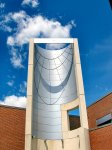 |
New Haven |
Connecticut |
USA |
Cylindrical Dial |
Dial 664 |
| A nearly 50 foot tall vertical concave cylindrical projection dial of precast concrete lined with aluminum panels and with an aluminum band projection gnomon. The curvilinear interior surface is inscribed with vertical hour lines and horizontal solstice and equinox marks. The band gnomon features a 2.5 inch diameter hole that projects an image of the sun on the silver-colored interior surface against a shadow cast by the gnomon band itself. |
| |
| |
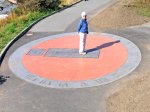 |
Victoria |
British Columbia |
Canada |
Analemmatic Dial |
Dial 663 |
| A 20 foot overall tinted concrete analemmatic dial with brass numerals, aluminum and granite slabs. Distance between major axis and small hour marks is 16.4 feet. Brass Roman numerals 10 inches high are set in a grey outer ring. Longitude and EOT corrections are marked beside the monthly date marks. A plaque commemorating the British Columbia 150 year celebration includes instructions on use and information on the dial designers and sponsors. |
| |
| |
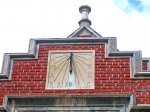 |
Portland |
Oregon |
USA |
Vertical Dial |
Dial 662 |
| A classic stone 20 x30 inch south facing vertical dial with bronze gnomon on brick building above sally port about 30 feet above grade. Hour lines with Roman numerals are corrected for longitude. Flanking the sally port are carved figures of Lux, or light, with open eyes on the east and Nox, or night, closing its eyes for sleep on the west. Reed College is a west coast "Ivy League" college following the Collegiate Gothic traditions of Oxford, Cambridge and the eastern US colleges. |
| |
| |
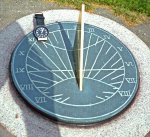 |
Calgary |
Alberta |
Canada |
Horizontal Dial |
Dial 661 |
| A 9 inch diameter horizontal dial of Welsh green slate with brass gnomon. Hour lines show DST with longitude correction. Declination lines are shown for solstices and equinoxes. The gnomon includes a NASS logo. The dial sits atop a stone plinth with 12 inch diameter top.
The original Sundial of Hope, sponsored by Child Find of Alberta, was placed in 1993 on an original plinth dating to before WW2. The simple dial installed in 1993 had been vandalized and the gnomon was missing. Roger Bailey designed and built this replacement dial to commemorate the 10th Anniversary of the founding of NASS. The new dial was unveiled during the 2003 NASS Conference Sundial Tour. |
| |
| |
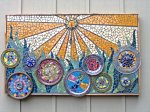 |
Portland |
Oregon |
USA |
Vertical Dial |
Dial 660 |
| A 4 x 2.5 foot south-facing vertical dial of mosaic tile whose hour lines include longitude correction. |
| |
| |
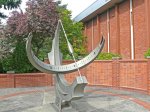 |
Vancouver |
Washington |
USA |
Equatorial Dial |
Dial 659 |
| A 2 meter diameter ring equatorial dial of welded anodized aluminum plate. The dial face shows Arabic numerals with hour and quarter-hour marks. This face can be moved for longitude correction and DST, and was originally adjusted to correct periodically for EOT. In 2009, the original straight gnomon was replaced with an analemmic gnomon, eliminating the need to adjust or correct for EOT. |
| |
| |
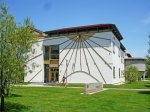 |
Redlands |
California |
USA |
Vertical Dial |
Dial 658 |
| A 60x40 foot vertical dial of stucco, wood and brass, filling the south exterior wall of the building. Roman hour numerals show PST; Arabic hour numerals show PDT. Summer and winter solstice and the equinox lines are shown; the shadow of a nodus on the gnomon indicates the date.
Dr. Nordgren explains that the shadow of the 10-inch diameter nodus "is just the right size to take into account periods when sundials are fast or slow relative to clock time. When dials run their slowest, the leading edge of the nodus shadow gives the accurate time. During periods when dials run their fastest the trailing edge gives the accurate time."
Dr. Nordgren was among the seven designers of the sundials used on the NASA Mars Rovers in 2004. |
| |
| |
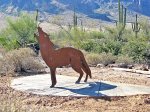 |
Gold Canyon |
Arizona |
USA |
Horizontal Dial |
Dial 657 |
| Built as an Eagle Scout project, this 10 x 5 foot semicircular concrete and steel dial features a 3 foot tall figure of a coyote as the gnomon. The tip of the coyote's nose functions as a point-in-space gnomon. The figure is placed well forward, limiting the times and dates the nose-tip shadow will fall within the hour circle to about 9 am to 3 pm on dates near the summer solstice. |
| |
| |
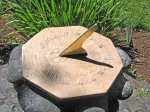 |
Colwood |
British Columbia |
Canada |
Horizontal Dial |
Dial 656 |
| A 12 inch octagonal stone horizontal dial with Roman hour numerals. Dial face depicts sun rays radiating from a central Beau Soleil to the hour numerals and outer time scale, which displays 5 minute graduations.
This historic dial dates from the original Pendray House on the Havenwood, built in 1928. The dial was in poor condition and the gnomon was missing. In July, 2009, NASS member Roger Bailey cleaned the dial, highlighted the markings and fabricated and installed a new brass gnomon.
The property is now Essencia at Esquimalt Lagoon, a private resort community but with public access for community activities. A stone path and arch lead to the dial, nearly overshadowed by a large tulip tree. |
| |
| |
 |
Omaha |
Nebraska |
USA |
Armillary Sphere |
Dial 655 |
| A five foot diameter stainless steel armillary dial with central gnomon rod and equatorial, horizon, meridian and equinoctial colure rings. CST and CDST hours are marked with Arabic numerals. The dial rests on a polished black granite base of two supporting arms. The dial is located at the center of the Robert H. Storz Family Rose Garden within Lauritzen Gardens. Dial sits atop a two-arm polished black granite base approximately 4 feet tall.
Viewing the dial requires paid admission to the Gardens. |
| |
| |
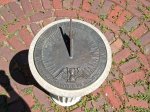 |
Omaha |
Nebraska |
USA |
Horizontal Dial |
Dial 654 |
| A cast bronze horizontal dial with Roman hour numerals and fifteen-minute marks on a pedestal in a stone courtyard. Dial face includes a depiction of an hour glass with wings and a motto, GROW OLD ALONG WITH ME THE BEST IS YET TO BE. Dial sits on a three foot high fluted circular cast pedestal. |
| |
| |
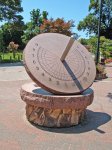 |
Omaha |
Nebraska |
USA |
Equatorial Dial |
Dial 653 |
| A five foot granite equatorial dial on a granite and stone pedestal with a 5 inch diameter stainless steel gnomon extending through the dial face. Arabic hour numerals for 4 AM to 9 PM are shown on the north face and for 6 AM to 7 PM on the south face. Dial is within the Henry Doorley Zoo which may require admission to see the dial, which is a memorial to Marcia Bekins Shepard. Dial sits on a granite disk atop a mortared stone pedestal. |
| |
| |
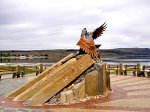 |
Soap Lake |
Washington |
USA |
Sculpture/Artwork |
Dial 652 |
| A monumental, 1-1/3 life-size bronze, steel and basalt rock sundial sculpture of a human figure with raised arm serving as a gnomon. The sculpture, "Calling the Healing Waters," depicts a young Native American couple as Father Sky and Mother Earth, sacred essence of rain and minerals connecting and bringing healing. Reflecting ethnic and historical themes, the winged warrior protects and comforts the maiden holding a catch basin for the healing waters. The sculpture was commissioned to honor the healing properties of the waters of Soap Lake. |
| |
| |
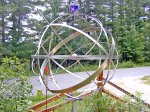 |
Westfield |
Wisconsin |
USA |
Armillary Sphere |
Dial 651 |
| A 42 inch diameter stainless steel armillary dial with central brass sphere and topped by a 100 mm cobalt blue crystal ball. The armillary includes equatorial, meridian, tropic (2), horizon and colure rings. Above the armillary is a weathervane featuring a landing bald eagle with Swarovski crystal eye. Hour markings are notched on the equatorial ring. The armillary rests on a 43 inch high tapered stainless steel pyramidal base. The overall height of the dial and weathervane is 10 feet. The dial sits on a 43 inch high, 8x8 inch tapered pyramidal stainless steel pedestal.
Dial is on private property but is visible from Fourth Avenue. Owner asks that viewers wanting closer access contact him by phone. |
| |
| |
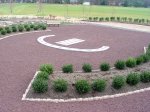 |
Skippack |
Pennsylvania |
USA |
Analemmatic Dial |
Dial 650 |
| A concrete and engraved brick analemmatic dial set in a garden of crushed rock. |
| |
| |
 |
Gastonia |
North Carolina |
USA |
Horizontal Dial |
Dial 649 |
| A 56 inch horizontal dial of stone masonry with wrought iron gnomon. Dial center filled with crushed rock with Roman numerals on perimeter stones. Dial is longitude corrected to EST and the EOT correction is shown on an adjacent landscape stone.
Dial is on private property but can be seen from the public street. For closer viewing, contact owner. |
| |
| |
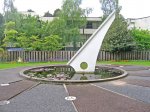 |
Vancouver |
British Columbia |
Canada |
Horizontal Dial |
Dial 648 |
| A large concrete and pebble horizontal dial with a 30 foot high gnomon. Hour lines are wood dividers in concrete with Roman numeral hour markers. Dial center and gnomon are situated in a lily pond.
Dial is on private property but is fully visible from public street. |
| |
| |
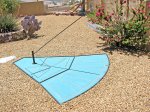 |
Lake Havasu City |
Arizona |
USA |
Horizontal Dial |
Dial 647 |
| An 8 x 9 foot horizontal dial of powder coat painted aluminum panels 1/4-inch thick assembled onto a concrete pad. Perimeter shows Arabic hour numerals 9-2 with 5-minute dots placed in arcs below the numerals. EOT correction is provided through four graphics on the dial face under the gnomon and sliding "T Square" indicators showing the corrections on rulers. EOT values are corrected for longitude. Dial face plates are supported on poured concrete pad.
Dial is on private property. Contact the owner to arrange viewing. |
| |
| |
 |
Holt |
Michigan |
USA |
Equatorial Dial |
Dial 646 |
| A four foot high equatorial dial possibly of painted cast aluminum on a four foot high segmented granite pedestal. Hour ring displays Roman numerals for EST with five minute marks with longitude correction. Tiles of pedestal bear names and birth/death dates of those memorialized. |
| |